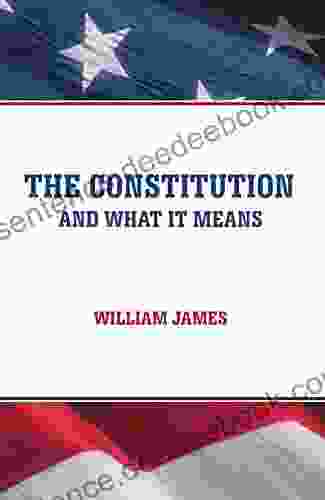The Constitution and What It Means: A Comprehensive Guide to the Foundation of American Law

The Constitution of the United States is the supreme law of the land, a foundational document that has shaped American society and government for over two centuries. It is a living document, subject to interpretation and amendment, reflecting the ever-evolving nature of the nation it governs. In this article, we delve into the intricate framework of the Constitution, exploring its history, principles, and significant provisions that have safeguarded the rights and liberties of American citizens. Whether you're a student studying civics, a lifelong resident seeking a deeper understanding, or a newcomer to the United States eager to grasp the bedrock of its legal system, this comprehensive guide will illuminate the Constitution and its profound significance.
Historical Context and Genesis
The Constitution emerged from the crucible of the American Revolution, a time of upheaval and aspiration. After declaring independence from British rule in 1776, the nascent United States faced the daunting task of crafting a new government that would balance order and liberty, central authority and state autonomy. The Articles of Confederation, ratified in 1781, proved inadequate, failing to establish a strong enough central government to address the nation's pressing challenges.
5 out of 5
| Language | : | English |
| File size | : | 316 KB |
| Text-to-Speech | : | Enabled |
| Screen Reader | : | Supported |
| Enhanced typesetting | : | Enabled |
| Word Wise | : | Enabled |
| Print length | : | 174 pages |
In response, a group of delegates convened in Philadelphia in 1787 to draft a new Constitution. Led by George Washington, James Madison, and Benjamin Franklin, among others, the Constitutional Convention grappled with fundamental questions about the structure and powers of government, the relationship between the states and the federal government, and the protection of individual rights. After months of intense debate and compromise, the Constitution was completed and submitted to the states for ratification.
Principles and Structures
The Constitution is predicated on several enduring principles that have guided American governance since its inception. These principles include:
- Popular Sovereignty: The government derives its authority from the consent of the governed, not from a monarch or divine right.
- Limited Government: The powers of government are not absolute but are carefully defined and constrained by the Constitution.
- Separation of Powers: The government is divided into three branches—legislative, executive, and judicial—each with its distinct powers and responsibilities.
- Checks and Balances: Each branch of government has the ability to check the power of the other branches, preventing any one branch from becoming too powerful.
- Federalism: The Constitution establishes a federal system of government, dividing power between the national government and the states.
The Constitution outlines the structure and powers of the three branches of the federal government:
Legislative Branch
The legislative power of the federal government is vested in Congress, a bicameral body composed of the Senate and the House of Representatives. The Senate is composed of two senators from each state, while the House of Representatives is composed of members elected from districts within each state, based on population. Congress has the power to make laws, declare war, raise and support armies, and impeach the President and other federal officials.
Executive Branch
The executive power of the federal government is vested in the President, who is both the head of state and the commander-in-chief of the armed forces. The President has the power to veto legislation passed by Congress, appoint federal judges and other officials, and grant pardons.
Judicial Branch
The judicial power of the federal government is vested in the Supreme Court and lower federal courts. The Supreme Court is the highest court in the land and has the power to interpret the Constitution and to overturn laws that it deems unconstitutional.
Bill of Rights
The first ten amendments to the Constitution, known as the Bill of Rights, were adopted in 1791 to address concerns about the potential for government encroachment on individual liberties. The Bill of Rights includes provisions that protect freedom of speech, press, religion, and assembly, as well as the right to bear arms, the right to a fair trial, and the right to be free from unreasonable searches and seizures. The Bill of Rights has been instrumental in safeguarding the fundamental rights and freedoms of American citizens.
Amendments and Interpretations
The Constitution is a living document that has been amended 27 times since its ratification. Amendments can be proposed by Congress or by a convention of the states and must be ratified by three-fourths of the states.
The Constitution has also been interpreted by the Supreme Court over the years, shaping its meaning and adapting it to changing circumstances. Landmark Supreme Court cases such as Marbury v. Madison (1803) and Brown v. Board of Education (1954) have had a profound impact on American law and society.
The Constitution of the United States is a remarkable document that has stood the test of time. It is a testament to the wisdom and foresight of its framers and a source of inspiration for generations of Americans. Its principles of limited government, separation of powers, and the protection of individual rights have ensured the stability and prosperity of the United States. The Constitution remains a vibrant and essential guide for American governance, a beacon of hope and a symbol of the nation's enduring commitment to liberty and justice for all.
5 out of 5
| Language | : | English |
| File size | : | 316 KB |
| Text-to-Speech | : | Enabled |
| Screen Reader | : | Supported |
| Enhanced typesetting | : | Enabled |
| Word Wise | : | Enabled |
| Print length | : | 174 pages |
Do you want to contribute by writing guest posts on this blog?
Please contact us and send us a resume of previous articles that you have written.
 Book
Book Novel
Novel Chapter
Chapter Story
Story Genre
Genre Reader
Reader Paperback
Paperback E-book
E-book Magazine
Magazine Newspaper
Newspaper Sentence
Sentence Bookmark
Bookmark Glossary
Glossary Foreword
Foreword Annotation
Annotation Manuscript
Manuscript Codex
Codex Bestseller
Bestseller Classics
Classics Library card
Library card Autobiography
Autobiography Memoir
Memoir Encyclopedia
Encyclopedia Thesaurus
Thesaurus Narrator
Narrator Character
Character Librarian
Librarian Catalog
Catalog Card Catalog
Card Catalog Stacks
Stacks Archives
Archives Study
Study Lending
Lending Academic
Academic Journals
Journals Special Collections
Special Collections Thesis
Thesis Awards
Awards Reading List
Reading List Textbooks
Textbooks James Monaco
James Monaco Ann Southworth
Ann Southworth Barry Ahern
Barry Ahern Jacob Bercovitch
Jacob Bercovitch Vince R Ditrich
Vince R Ditrich F H Buckley
F H Buckley David Morrill
David Morrill Megan O Russell
Megan O Russell Lori D Ginzberg
Lori D Ginzberg Jean Hanff Korelitz
Jean Hanff Korelitz Kindle Edition
Kindle Edition Rick Friedberg
Rick Friedberg F A Chekki
F A Chekki Electrobleme
Electrobleme Auberon Herbert
Auberon Herbert Ester R Fuchs
Ester R Fuchs Louie Mckinney
Louie Mckinney Carol Tallon
Carol Tallon Michael Lavigne
Michael Lavigne Andrew Steinmetz
Andrew Steinmetz
Light bulbAdvertise smarter! Our strategic ad space ensures maximum exposure. Reserve your spot today!
 Osamu DazaiFollow ·19.7k
Osamu DazaiFollow ·19.7k Franklin BellFollow ·14.9k
Franklin BellFollow ·14.9k Vincent MitchellFollow ·8.7k
Vincent MitchellFollow ·8.7k Vince HayesFollow ·12.9k
Vince HayesFollow ·12.9k Elliott CarterFollow ·19.3k
Elliott CarterFollow ·19.3k Craig BlairFollow ·5.1k
Craig BlairFollow ·5.1k Demetrius CarterFollow ·12.6k
Demetrius CarterFollow ·12.6k Oscar BellFollow ·17.8k
Oscar BellFollow ·17.8k

 Darren Nelson
Darren NelsonLife of Napoleon Bonaparte, Volume II: His Rise to Power
**** Napoleon...

 Reed Mitchell
Reed MitchellLucy Sullivan Is Getting Married: A Tale of Love,...
Lucy Sullivan is a...

 Chuck Mitchell
Chuck MitchellBeginner's Crash Course on Python Language: Getting...
Python is a widely used programming...

 Henry Hayes
Henry HayesThreads Fitting For Every Figure: A Comprehensive Guide...
Finding the perfect fit can be a...

 Duane Kelly
Duane KellyA Comprehensive Cat Guide to Money: Feline Finance for...
In the world of finance, humans have...

 Jedidiah Hayes
Jedidiah HayesThe Sentimental Hippo And His Friends
Harvey the hippo was a very sentimental...
5 out of 5
| Language | : | English |
| File size | : | 316 KB |
| Text-to-Speech | : | Enabled |
| Screen Reader | : | Supported |
| Enhanced typesetting | : | Enabled |
| Word Wise | : | Enabled |
| Print length | : | 174 pages |












